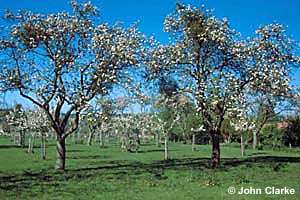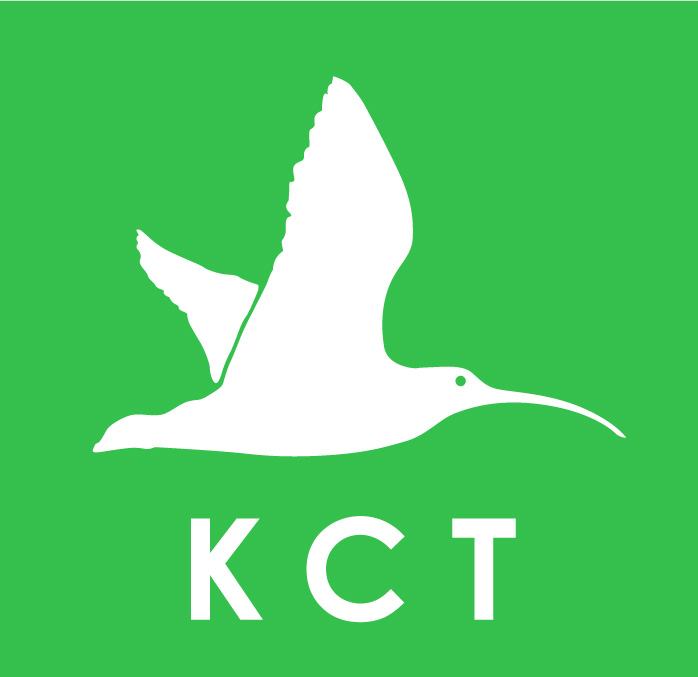Background
It was almost certainly the Romans who brought the apple to Britain and orchards must have been a
part of our landscape for many hundreds of years. They would have been particularly important
features of rural life, providing a local source of fresh food as well as a marketable
product. The 1610 map of the area shows several orchards in Kemerton – it would appear that
most farms, smallholdings and even cottages had their own orchard. Orchards thrived around
Kemerton until well into the last half of the twentieth century. Then, the advent of cheap,
imported supermarket fruit and EU incentives to change agriculture led to a dramatic decline.
It would be a few years before the true value of orchards – as landscape features, as havens for
wildlife and a potential farming crop – was realised. By then, many old orchards had been
destroyed or neglected, with the loss of old apple varieties that had been developed over hundreds
of years. |
 |
Since the early 1980’s Kemerton Estate has been pursuing a policy of integrating good
conservation principles into a modern farm. Kemerton Conservation Trust was established in 1987 to help
plan, oversee and monitor conservation issues on the estate – and beyond. The restoration of old
orchards, together with the conservation of old apple varieties soon became one of its priorities.
The Lillans Orchard (‘Ley Lands’ on the 1610 map) was identified for the major part of the
orchard restoration work. It lies close to the heart of the village, is overlooked by a number of
houses and a public footpath crosses it. Years of neglect, damage by grazing animals and an infection
by Honey Fungus had destroyed most of the old trees. The orchard is grazed by Red Poll cattle and their
young, and by sheep.
Aims
-
The restoration of The Lillans – to include eating, culinary and cider
apples.
-
The conservation of old apple varieties – with particular emphasis on those originating
in Gloucestershire, Herefordshire and Worcestershire.
-
Wherever possible, to consider the importance of orchards for wildlife such as birds and
invertebrates.
-
To conserve traditional village landscape.
-
To promote public awareness of orchards.
-
To provide graftwood and budwood of old varieties for local orchard conservation
schemes
Kemerton Conservation Trust also manages and is attempting to
restore:
- Conygree – a small, mixed orchard with cattle grazing.
- Grange Orchard – re-planted in 2003 – mainly apples
- Betty Daffurn’s Orchard – an old orchard purchased with donations from the local community
to save it from housing development. Being restored and varieties identified. Mixed but
mainly apple.
- Upstones Orchard – a damson orchard in a traditional, small hay meadow.
- Second Orchard – an old perry pear orchard that has been re-planted.
In addition, the walled garden at Kemerton Court has been restored and holds some of the apple
collection on smaller rootstocks.
The restoration project
Restoration included the protection and conservation of the few remaining
apple trees and the re-planting. Limited resources on the estate meant that the project would be spread over
many years. The first plantings took place in 1987 and since then there have been few years when further
plantings have not taken place. The process of locating sources of local varieties or arranging for the
budding or grafting onto stock-wood is slow. It is likely to take at least a further five years to complete
the project. That is, however, because Kemerton has chosen to concentrate on the conservation of older
varieties rather than to pursue a more commercial route.
The orchard apple trees are all standards – the variety required is grafted onto a vigorous,
tall-growing stock. This is necessary as the orchard continues its other traditional function – to
provide grazing for cattle and sheep. Modern, commercial orchards are usually planted with low-growing
trees and bushes to facilitate harvesting.
A project of this size and complexity benefits from support. Over the years advice and
financial support has been given by a number of bodies. The original plantings were part-funded by a
Worcestershire County Council scheme whilst later plantings are assisted by the Countryside
Stewardship scheme. Bulmers Ltd. hosted a staff visit to their orchards near Hereford
and to several farm producers under contract to them. The Brogdale Horticultural Trust, which
holds the largest apple collection in Britain, has been consulted on occasions and has supplied graft-wood
for Bulmers and others to grow trees to order. Pershore Horticultural College runs courses on
grafting, budding and pruning which Kemerton staff have attended. The Royal Horticultural
Society has ‘Apple Groups’ whose members attend courses and swap information through newsletters and
field trips. Kemerton staff also received advice and training from the local Dumbleton Nurseries
and regularly liaise with members of the orchard charity Common Ground.
The apple trees are widely spaced to allow for their larger size, to avoid shading out the
grazing beneath and to allow farm machinery to operate. The younger trees require protection against
rabbits as well as the cattle and sheep. Over the years, several guard designs have been tried – the
latest is a 2m high, rigid wire mesh cut to size, then folded and clipped to form a 30cm dia shield around
the tree. The guard is fixed to a large stake driven firmly into the ground prior to planting.
For the first few years it is necessary to control competing weeds around the base of each tree.
Initially spraying was carried out in early spring but now a modern design of ‘mulch mat’ is being
tried.
Although the aim is not to maximise fruit production, nevertheless the young trees require
regular pruning to encourage them to reach the necessary height and to take out any side growth from below
the graft level.
Project plusses
- To date, the Kemerton Trust orchards hold over 200 named varieties of apple
- The orchards comprise approximately 450 trees
- ‘Tree maps’ have been compiled and are updated regularly
- An ‘Apple Directory’ has been produced. This provides details of all varieties, their
location within several Kemerton orchards and their origins (where they were first bred and in what
year)
- Mistletoe is not yet a commercial crop but is harvested at intervals
- The orchard has already become a source of graft-wood for other local growers
- The restoration project has been welcomed by local residents
- Kemerton Orchard Workers has been established by local people who are supporting our
orchards by helping with the management, focussing mainly on Daffurns Orchard. They arrange their
own funding and training but work closely with the Trust.
- As the orchard develops the requests to visit increase
- Kemerton Conservation Trust endeavours to share its experience of orchard restoration with
others, via Apple Groups, County Trusts and The Farming and Wildlife Advisory Group
Project
minuses
- Lack of manpower resources has meant that aftercare has been neglected at times. This
has resulted at best, in the slow development of trees and at worst, in the death of a small
percentage. The problem should be addressed within the next year or two
- At one stage, the Trust bought ‘whips’ and ‘maiden’ trees to grow on – rather than the more
expensive standard size. It was amongst this group of trees that most losses and slower growth was
experienced
- Due to a frustrating mix-up during one planting year, the identification of around 25 trees
was lost. A (possibly expensive) programme of identification is now underway – illustrating the
importance of keeping good records. Un-named older trees are also slowly being
identified
- Although all the named varieties are marked on the ‘tree map’ it has so far been impossible
to find an inexpensive method of labelling each tree whilst taking care not to cause damage. The
latest design is made from clay donated by Conderton Pottery. KCT staff fashion ‘discs’ of about
6-10cm dia., engrave them and pierce a fixing hole. Conderton Pottery then fires them (free of
charge) and the salt-glazed labels are then attached to the tree or the tree guard using strong,
plastic-covered wire
The
future
- The project commits Kemerton Estate to the long term management of The Lillans and other
orchards.
- KCT would like to see the orchards become organic – on ecological grounds and as a way of
increasing its commercial potential.
- Ways of harvesting and marketing the fruit crop must be considered soon. However, it
is unlikely that present estate resources could be diverted to this. Therefore the use of
contractors or the sale of the crop ‘on the bough’ might be considered. The crop’s value may well
be influenced by any future demand for commercial buyers and consumers selecting apples because of their
variety or because they are organically produced.
- The demand for Mistletoe appears to increase, with home-grown stock supplemented by
imports. Some further income from the orchard may be derived through a contractual arrangement to
harvest and market the crop.
(J. Clarke – 2002)
| 








